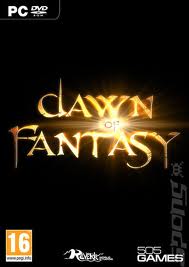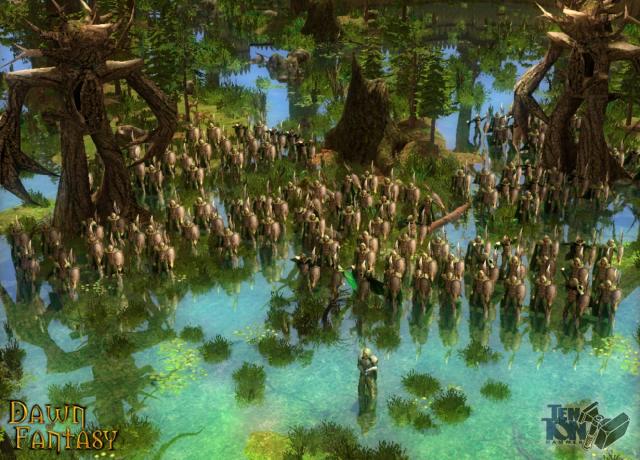Search
[{{{type}}}] {{{reason}}}
{{/data.error.root_cause}}{{{_source.title}}} {{#_source.showPrice}} {{{_source.displayPrice}}} {{/_source.showPrice}}
{{#_source.showLink}} {{/_source.showLink}} {{#_source.showDate}}{{{_source.displayDate}}}
{{/_source.showDate}}{{{_source.description}}}
{{#_source.additionalInfo}}{{#_source.additionalFields}} {{#title}} {{{label}}}: {{{title}}} {{/title}} {{/_source.additionalFields}}
{{/_source.additionalInfo}}- Details
- Category: Computer
- By Tritherian
- Hits: 8388
Dawn of Fantasy

Dawn of Fantasy
Developed By: Reverie World Studios
Published By: 505 Games
Release Date: September 6, 2011
Available On: PC
Genre: Massively Multiplayer Online Real-Time Strategy
ERSB Rating: Teen
Single Player/Multiplayer
MSRP: $24.99 (no monthly fees, micro-transactions)
Thank you Reverie World Studios for sending us this game to review!
In the land of massively multiplayer online games, the role playing genre has long reigned supreme. But recent years have seen more games bringing different types of gameplay into an online, persistent world. Dawn of Fantasy is one such game. It takes the city building and army creation gameplay of a real time strategy game into an online realm. If you haven’t guessed already, it’s set in a standard “high-fantasy” world filled with men, elves, and orcs. That’s not the only thing that will seem familiar to veterans of the genre. Reverie World Studios has taken many pages out of other RTS games’ play books to put together a game for those who want to build something that exists in a world larger than their own hard drives.
But the road has not been a smooth one for this ambitious project. In development for ten years, the game’s launch was plagued with a number of bugs that made it almost unplayable. Since that time, there have been a number of patches for the game in an attempt to make it more stable. The largest patch yet, 1.2, went live on the 18th of February. This patch not only fixed bugs, but added a better system for co-op and PvP play, as well as an interactive tutorial to help ease in new players. These tutorials are about the closest you get to a singleplayer campaign. The only other offline game modes are castle siege skirmishes and the “kingdom wars” mode (which gives you a taste of moving in the world map and managing cities). But you’ll have to go online to get to the real meat of the game.

Strong Points: Lots of gameplay concepts brought together; three fully fleshed out factions; large world with plenty of cities to lay siege to; active developer support.
Weak Points: Poorly optimized; still rather buggy; mediocre production values; slow paced; minimal storyline.
Moral Warnings: Fantasy violence, blood, use of magic, alcohol references, mild suggestive dialog and mild language.
You start out by choosing a race (Orc, Elf, or Human) and one of three regions in which to set up your city. You can then choose two traits for your hero unit, some of which will only affect him and some that affect your whole city. After this you will be treated to a brief narration that sets up some backstory. From there you are given control of a hero unit, a few workers and a central building to start your city with. There is also a quest giver that gives you some tasks to get you started on your way to building a city. The quests themselves are pretty standard: kill these bandits, gather this many resources, etc. Later on, as your city grows and you complete quests, you will meet other characters that will give you more story related missions.
Dawn of Fantasy takes a number of gameplay elements from other RTS games and melds them into two main modes. The world map gives a broad view of the surrounding area and allows you to move armies from one city to the next. The actual fighting, resource gathering, and city building take place from a bird’s eye view of the immediate area around a battlefield, or city. Both modes happen in real time, with no pausing or turns when going from one to the other. This means that armies you send marching off to a distant city in the world map will continue to march while you recruit more units and fortify your city in the RTS mode.
But before you can march off to plunder enemy lands, you must gather, or buy, the necessary resources. The main economic unit of any city is the peasants. These hard-working commoners can be tasked with gathering food, wood, gold or stone; and in battles they can also repair structures and loot corpses. There is also a resource trading system that enables you to take surplus goods of one kind and convert it into another. This is nothing new to RTS games, but the way it’s done is fairly unique. Instead of a market building that magically transforms your wood into gold, you need to transfer the goods into an army that has a cart (or other pack unit) and take it to an NPC town. From there you can sell goods for gold and buy any other resource with it. Then you’ll have to bring back your bounty and transfer it back into your city’s stores before you can use it. This can be a little time consuming, but don’t worry about time too much. Unlike most other “gather, build and conquer” RTS games, speed isn’t all that important. You can’t even be attacked by another player until your city grows to a certain size. And even NPC bandits will wait politely outside your city to be slaughtered. Which is good because some of the more important buildings literally take hours to build (such as those that advance your “tech” level). A fifth resource is Influence. This is gained through some quest and PvP battles. You can also buy them from the Dawn of Fantasy’s official web site for real money. You can use Influence to by buildings, elite units, and resources.

Higher is better
(10/10 is perfect)
Game Score - 66%
Gameplay - 14/20
Graphics - 6/10
Sound - 7/10
Stability - 3/5
Controls - 3/5
Morality Score - 67%
Violence - 3.5/10
Language - 7.5/10
Sexual Content - 8/10
Occult/Supernatural - 7/10
Cultural/Moral/Ethical - 7.5/10
The main bulk of your time that is not spent mining, trading or building will be spent commanding your armies in battle. Unlike many mainstream fantasy RTS and RPG games (especially MMOs) these battles are not bloodless. As units take damage they will get cuts all over their bodies. When they die they will be covered in blood and their bodies will not fade until a peasant comes to loot the corpse. There is also use of magic, mostly used by the elves. In fact, the elves use magic to gather all of their resources, as they don’t believe in taking things from nature. This preservation of nature is so important to them that, in one early elvish mission, you are tasked with killing a group of human hunters so as to save some deer. Not that humans are all sweethearts either. In fact, most every human unit will swear at you every other time you select him. D***, h*** and “bloody” are all used as expletives. There is also a mission that has you searching for missing ale shipments (no drinking is actually shown), and the human quest giver keeps wanting to throw a party with “dancing girls” (he never gets them). And then there are orcs. They like to fight, a lot. Plus they not only get gold from looted corpses, but food as well. Yes, that means exactly what you think it does, though you never see the corpse-eating (the bodies just disappear, the same as with looting).
The look of the game is a bit dated, with blocky models, objects that “pop” in and out quite a lot, blurry textures and an art style that tends towards the generic side. Not to say that it’s all bad. The hero units fare a little better than most units, though there are still some issues when viewed up close. The elves are probably the best looking of the three factions - both in terms of technical appearance and design, with buildings that integrate whole trees into their construction. The environments themselves also look okay, with good use of colors and nice vegetation, with a full day-night cycle changing the lighting and shadows through the course of the game. Sounds are a bit mixed. While the in-game music helps enhance the mood, and the voice acting is passable, the sound effects tend to be low quality and unvarying.
Ultimately Dawn of Fantasy is a collection of good ideas woven together in a way that lends itself well to online play. But not all the pieces fit perfectly, with many rough edges keeping them from meshing. Most of the stability issues that plagued the initial release have been fixed, but the core gameplay still lacks the refinement to make it a truly great RTS. Units move sluggishly, battles don’t lend themselves well to tactical play, and it’s hard to read most units to tell what they are. But even if it were a great RTS it would still feel lacking in respect to its MMO features. The lack of customization options make your city, hero and units all seem much the same as any other player’s. And while there is an upgrade system that is quite deep for an RTS, it’s nowhere near what most MMO players will have come to expect. The appropriateness of the game is in something of a strange place, with more blood and swearing than some, but not as much as in many dark fantasy worlds. As a result, Dawn of Fantasy is hard to recommend wholeheartedly. And yet, there is definitely some enjoyment to be had here, for the right kind of gamer. You’ll just have to wade through some awkwardness to get to it and be willing to overlook some faults to get there.




